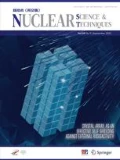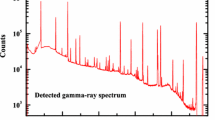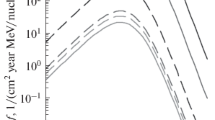Abstract
Identifying the geometric information of an object by analyzing the detected radiation fields is an important problem for national and global security. In the present work, an inverse radiation transport model, based on the enhanced differential evolution algorithm with global and local neighborhoods (IRT-DEGL), is developed to estimate the unknown layer thickness of the source/shield system with the gamma-ray spectrum. The framework is briefly introduced with the emphasis on handling the enhanced differential evolution algorithm. Using the simulated gamma-ray spectra, the numerical precision of the IRT-DEGL model is evaluated for one-dimensional source systems. Using the detected gamma-ray spectra, the inverse investigations for the unknown thicknesses of multiple shielding layers are performed. By comparing with the traditional gamma-ray absorption method, it is shown that the IRT-EDGL model can provide a much more accurate result and has great potential to be applied for the complicated systems.



Similar content being viewed by others
References
G.R. Gilmore, Practical Gamma-Ray Spectrometry, 2nd edn. (Wiley, Chichester, 2008). doi:10.1002/9780470861981
N.J. McCormick, Inverse radiative transport problems: a review. Nucl. Sci. Eng. 112, 185–198 (1992)
Y.Y. Huang, Y.Y. Chen, D.F. Tian et al., \(\gamma \)-Ray self-absorption of cylindrical fissile material. Nucl. Sci. Tech. 16(1), 17–24 (2005)
C.Y. Wu, D.F. Tian, Y.Y. Cheng et al., Gamma ray absorption of cylindrical fissile material with dual shields. Nucl. Sci. Tech. 16(5), 266–272 (2005)
A.F. Iyudin, V. Burwitz, J. Greiner et al., Gamma-ray absorption method (GRAM) application to the identification of egret unidentified sources. Astron. Astrophys. 468, 919–926 (2007). doi:10.1051/0004-6361:20066890
L.P. Zhang, L.Q. Wu, M.F. Wei, Study on the gamma passive analysis for the thickness of two layer shield materials. Nucl. Electr. Detect. Technol. 330(45), 322–324 (2015)
J. Mattingly, D.J. Mitchell, A framework for the solution of inverse radiation transport problems. IEEE Trans. Nucl. Sci. 57, 3734–3743 (2010). doi:10.1109/NSSMIC.2008.4774636
S.J. Norton, A general nonlinear inverse transport algorithm using forward and adjoint flux computations. IEEE Trans. Nucl. Sci. 44, 153–162 (1997). doi:10.1109/23.568797
J.A. Favorite, K.C. Bledsoe, Using the Levenberg–Marquardt method for the solution of inverse transport problems. Trans. Am. Nucl. Soc. 95, 527 (2006)
K.C. Bledsoe, J.A. Favorite, T. Aldemir, Application of the differential evolution method to solving inverse transport problems. Nucl. Sci. Eng. 169, 208–211 (2011)
K.C. Bledsoe, J.A. Favorite, T. Aldemir, Using the Levenberg–Marquardt method for solutions of inverse transport problems in one- and two-dimensional geometries. Nucl. Technol. 176, 106–126 (2011)
J.C. Armstrong, J.A. Favorite, Identification of unknown interface locations in a source/shield system using the mesh adaptive direct search method. Trans. Am. Nucl. Soc. 107, 375–377 (2012)
K.C. Bledsoe, J.A. Favorite, Using the Marquardt method for solution of inverse transport problems in two-dimensional cylinders. Trans. Am. Nucl. Soc. 98, 591 (2008)
J. Mattingly, D.J. Mitchell, Implementation and testing of a multivariate inverse radiation transport solver. Appl. Radiat. Isot. 70, 1136–1140 (2012). doi:10.1016/j.apradiso.2011.10.020
J. Mattingly, D.J. Mitchell, L.T. Harding, Experimental validation of a coupled neutron photon inverse radiation transport solver. Nucl. Instrum. Methods Phys. Res. Sect. A 652, 537–539 (2011). doi:10.1016/j.nima.2011.01.139
K.C. Bledsoe, J.A. Favorite, T. Aldemir, A comparison of the covariance matrix adaptation evolution strategy and the Levenberg–Marquardt method for solving multidimensional inverse transport problems. Ann. Nucl. Eng. 38, 897–904 (2011). doi:10.1016/j.anucene.2010.09.014
K.C. Bledsoe, Inverse methods for radiation transport. Ph.D. Thesis, Ohio State University (2009)
S. Das, A. Abraham, U.K. Chakraborty et al., Differential evolution using a neighborhood-based mutation operator. IEEE Trans. Evol. Comput. 3, 526–553 (2009). doi:10.1109/TEVC.2008.2009457
P.N. Suganthan, Differential evolution algorithm: recent advances. Lect. Notes Comput. Sci. 7505, 47–56 (2012)
Mcnp-a general Monte Carlo n-particle transport code, version 5. X-5 Monte Carlo Team, LA-CP-03-0245, Los Alamos National Laboratory (2003)
M. Garcia-Talavera, H. Neder, M.J. Daza et al., Towards a proper modeling of detector and source characteristics in Monte Carlo simulations. Appl. Radiat. Isot. 52, 777 (2000). doi:10.1016/S0969-8043(99)00244-4
D. Budjas, M. Heisel, W. Maneschg et al., Optimisation of the mc model of a \(p\) type Ge spectrometer for the purpose of efficiency determination. Appl. Radiat. Isot. 67, 706 (2009). doi:10.1016/j.apradiso.2009.01.015
Acknowledgements
The authors would like to acknowledge Ming-Cong Lan, Xiao-Jun Dang and Wei-Bo He for the discussions during the whole work.
Author information
Authors and Affiliations
Corresponding author
Additional information
This work was supported by the CAEP foundation for Development of Science and Technology (No. 2015B0103014) and National Natural Science Foundation of China (No. 11605163).
Rights and permissions
About this article
Cite this article
Chen, Y., Zhang, LP., Sai, X. et al. An enhanced differential evolution-based inverse radiation transport model for identification of unknown shielding layer thicknesses with gamma-ray spectrum. NUCL SCI TECH 28, 84 (2017). https://doi.org/10.1007/s41365-017-0231-x
Received:
Revised:
Accepted:
Published:
DOI: https://doi.org/10.1007/s41365-017-0231-x




